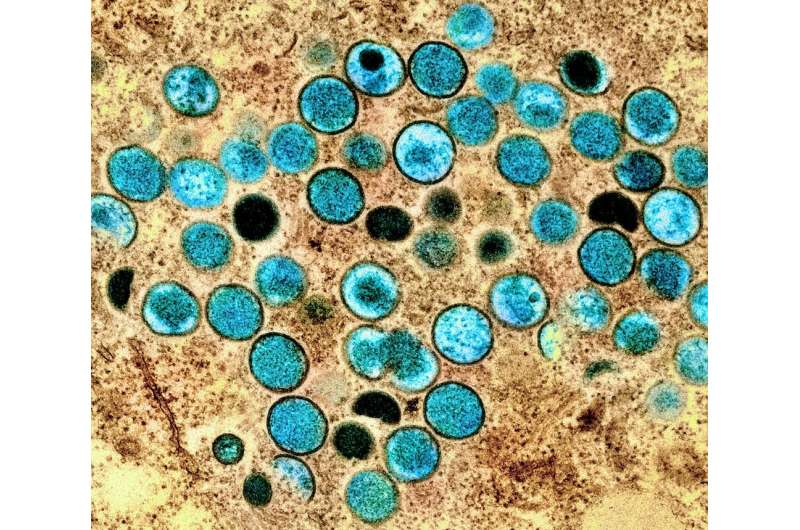A dog caught monkeypox from one of its owners, highlighting risk of the virus infecting pets and wild animals

A dog in Paris has , both of whom were infected with the virus, according to a scientific paper published on Aug. 10, 2022. This is the first case of a dog contracting the monkeypox virus through direct contact with skin lesions on a human.
I am a veterinary for more than 20 years. I study how these viruses evade the immune system and am working on modifying poxviruses to prevent infection as well as treat other diseases, including cancer.
With monkeypox spreading in humans throughout the world, my colleagues and I have begun to worry about the increased risk of monkeypox spreading from humans to animals. If monkeypox spreads to wildlife species in the U.S. and Europe, the virus could become endemic in these places—where it —resulting in more frequent outbreaks. The report of the infected dog shows that there is a decent chance these fears could become a reality.
A species-jumping virus
Monkeypox is a poxvirus in the same family as variola—the virus that causes smallpox—and cowpox viruses and likely evolved in animals before jumping to humans. Monkeypox causes painful lesions in both humans and animals and, in rare cases, can be deadly. Researchers have found the monkeypox virus in several species of , and in Africa, where the virus is endemic. Monkeypox does not need to mutate or evolve at all to be able to . It can easily spread from animals to people and back again.
Though there is a fair bit of research on monkeypox, a lot more work has been done on cowpox, a similar zoonotic poxvirus that is endemic in Europe. Over the years, there have been of from .
From people to animals
Until recently, most monkeypox infections occurred in specific areas of Africa where some wildlife species act as reservoirs for the virus. These outbreaks are usually contained quickly through isolation of infected individuals and vaccinating people around the infected individual. The current situation is very different though.
With nearly as of Aug. 17, 2022—and more than 12,500 cases in the U.S. alone—monkeypox is now widespread within the human population. The risk of any one person transmitting the virus to an animal—particularly a wild one—is small, but the more people are infected, the greater the chances. It's a numbers game.
There are a number of ways viruses can transfer from animals to people—called spillover—and from people back to animals—called spillback. Since monkeypox is most easily spread through direct skin-to-skin contact, it is a bit more difficult to transmit between species than COVID-19, but certainly possible.
The case of the dog in Paris provides a clear example of how cuddling or being close to a pet can spread the virus. Previous studies on poxviruses like monkeypox have shown that they can . This means that there is a risk of wild animals, likely rodents, catching it from human waste.
The monkeypox virus is also . While more research needs to be done, it is potentially possible that an infected person could discard food that would then be eaten by a rodent.
The chances of any one of these events happening is extremely low. But I and other virologists worry that with more people becoming infected, there is a greater risk that rodents or other animals will come into contact with urine, feces or saliva that is contaminated with the virus.
Finally, there is the risk of people giving monkeypox to a pet, which then passes it on to other animals. One case study in Germany described an outbreak of cowpox that was caused when someone took an infected cat to a veterinary clinic and . It is feasible that an infected household pet could spread the virus to wild animals somehow.
How to help
One of the key reasons that the World Health Organization was able to eradicate smallpox is that it only infects people, so there were no animal reservoirs that could .
Monkeypox is zoonotic and already has several animal reservoirs, though these are . But if monkeypox escapes into wild animal populations in the U.S., Europe or other locations, there will be always be potential for animals to spread it back to humans. With this in mind, there are a number of things people can do to reduce the risks with regard to animals.
As with any infectious disease, be informed about the signs and symptoms of monkeypox and how it is transmitted. If you suspect you have the virus, contact a doctor and isolate from other people.
As a veterinarian, I strongly encourage anyone with monkeypox to protect your pets. The case in Paris shows that , and it is likely that many , including cats, are susceptible, too. If you have monkeypox, try to have other people take care of your animals for as long as lesions are present. And if you think your pet has a monkeypox infection, be sure to contact a veterinarian so they can test the lesion and provide care when needed.
Even though monkeypox has been declared a public health emergency, it is unlikely to directly affect most people. Taking precautionary steps can protect you and your pets and will hopefully prevent monkeypox from getting into wildlife in the U.S., too.
Provided by The Conversation
This article is republished from under a Creative Commons license. Read the .![]()















